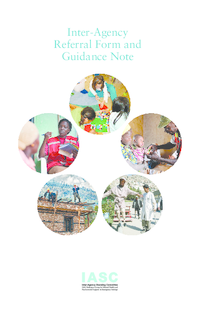
Manuals, Toolkits and Guidance, Policies, Standards, and Strategies
Inter-Agency Guidelines on the Guiding Principles and Minimum Standards for Supporting and Establishing Community-Based Child Protection Structures
Publication year:
2007
English
Format:
(399.5 KiB)
Publisher:
IASC, Inter-Agency Standing Committee,Ugandan Ministry of Gender, Labour and Social Development,UNICEF, United Nations Children's Fund
Every child, whether in a conflict/emergency situation or time of stability, is entitled to basic human rights, including the right to be protected and supported by their family, community, government and international community—all those who carry the responsibility to ensure the full development and well-being of the child is fostered, upheld, and protected.
In recognition of this right, in the spring of 2007 the Uganda Interagency Sub-Cluster on Child Protection launched a review of community-based initiatives supporting the protection of children in the Acholi, Lango, and Teso regions of Uganda. Funded by the Uganda MoGSLD, a gathering of 65 participants from various NGOs, CBOs, UN agencies and government agencies was held to discuss the findings, recommendations, and to develop a strategy for supporting community-based structures committed to the protection of children.
The comprehensive assessment revealed a number of successes demonstrated by community-based initiatives but also unveiled challenges too great to be ignored. It was determined that it would be too difficult to create a ‘one-size-fits-all’ model for protecting children in Uganda and yet, at a minimum, there was a need for creating standards and developing guiding principles to ensure that children were protected by established community-based structures.
The launch of these Guidelines serve as a means to optimize community experiences across Uganda, document best practices and lay the foundation for a harmonized protection scheme that incorporates guiding principles and minimum standards and indicators that can be measured and are agreed upon by all stakeholders involved in the protection of children.
Humanitarian efforts working with children require a very clear understanding of the roles and responsibilities towards the welfare and protection of children. These Guidelines offer an excellent opportunity not only for the improvement of the quality and support given to community-based child protection structures, but most importantly they help to achieve a greater protective environment and impact for children.
Read full abstract
Authors
View & Download
Document information
Publisher
Authors
Country
Region
Rights
© Author/Publisher
Keywords
Found a mistake? Help us improve!
If you have noticed a document assigned to the wrong author or any other inaccuracies, let us know! Your feedback helps us keep our data accurate and useful for everyone.
Share
Link
